Leadership Theories: Transactional and Transformational Analysis
VerifiedAdded on 2020/04/01
|13
|4009
|190
Report
AI Summary
This report provides a comprehensive analysis of two prominent leadership theories: transactional and transformational leadership. It begins by defining transactional leadership as a management approach focused on organizing, supervising, and controlling subordinates through a system of rewards and punishments, with Howard Schultz as an example. The report then explores the development, assumptions, characteristics, advantages, disadvantages, and applicability of transactional leadership, highlighting its effectiveness in structured environments. Subsequently, the report delves into transformational leadership, which emphasizes empowering employees to initiate change and achieve extraordinary results, with Elon Musk as an example. It examines the development, assumptions, characteristics, advantages, disadvantages, and applicability of transformational leadership, emphasizing its suitability for organizations undergoing transformation. Finally, the report provides a detailed comparison between the two leadership styles, offering insights into their distinct approaches and effectiveness in different contexts.
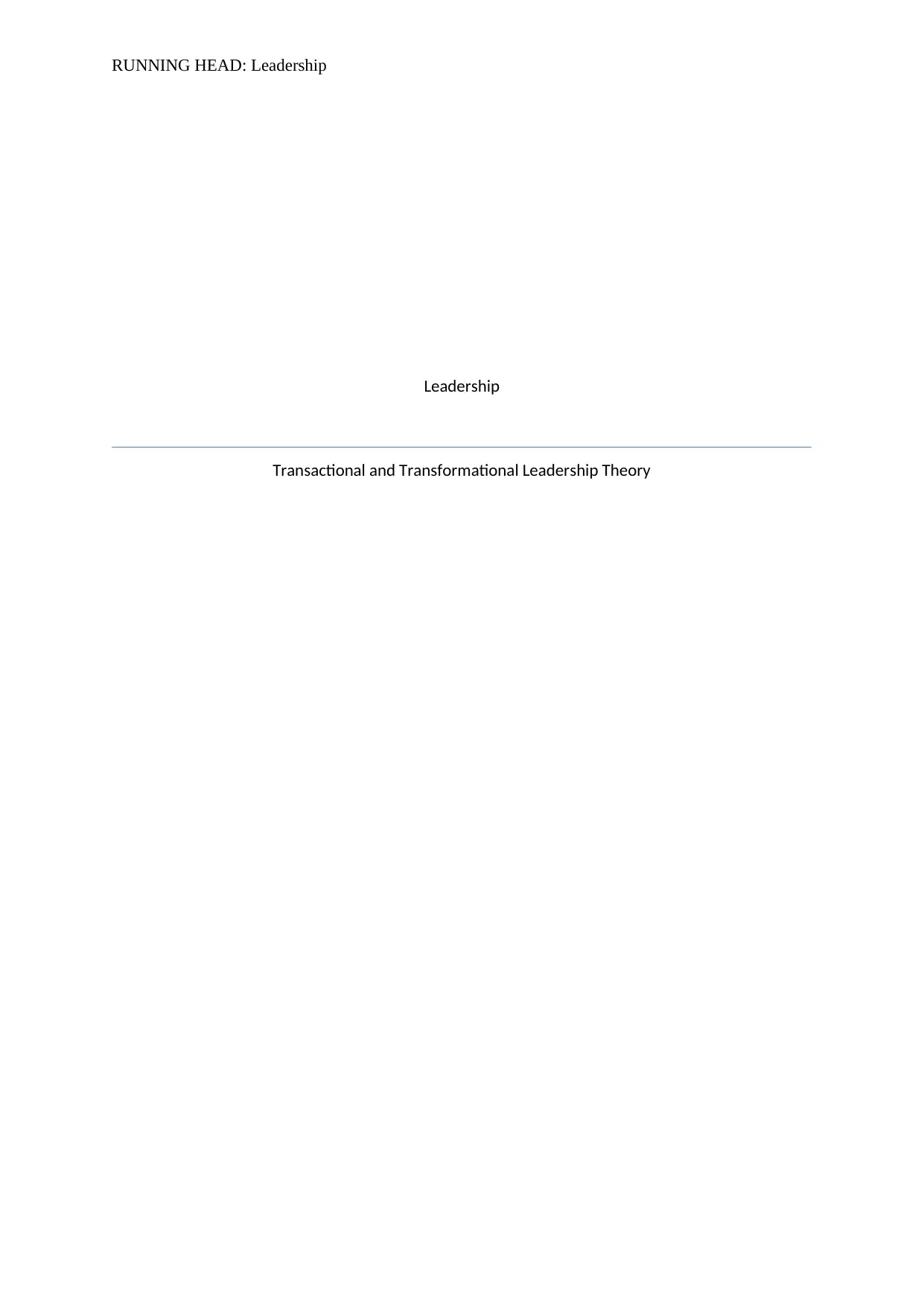
RUNNING HEAD: Leadership
Leadership
Transactional and Transformational Leadership Theory
Leadership
Transactional and Transformational Leadership Theory
Paraphrase This Document
Need a fresh take? Get an instant paraphrase of this document with our AI Paraphraser

Transactional and Transformational Leadership Theory 1
Contents
Introduction...........................................................................................................................................2
Transactional Leadership Theory..........................................................................................................2
Meaning of Transactional Leadership................................................................................................2
Development of Transactional Leadership........................................................................................3
Assumptions of Transactional Leadership.........................................................................................3
Characteristics of Transactional Leadership......................................................................................3
Advantages and Disadvantages of Transactional Leadership............................................................4
Applicability of Transactional Leadership.........................................................................................4
Example of Transactional Leader: Howard Schultz...........................................................................5
Transformational Leadership Theory....................................................................................................5
Meaning of Transformational Leadership..........................................................................................5
Development of Transformational Leadership..................................................................................6
Assumptions of Transformational Leadership...................................................................................6
Characteristics of Transformational Leadership................................................................................6
Advantages and Disadvantages of Transformational Leadership.......................................................7
Applicability of Transformational Leadership...................................................................................7
Example of Transformational Leader: Elon Musk.............................................................................8
Comparison between Transactional and Transformational Leadership..................................................8
Conclusion.............................................................................................................................................9
References...........................................................................................................................................10
Contents
Introduction...........................................................................................................................................2
Transactional Leadership Theory..........................................................................................................2
Meaning of Transactional Leadership................................................................................................2
Development of Transactional Leadership........................................................................................3
Assumptions of Transactional Leadership.........................................................................................3
Characteristics of Transactional Leadership......................................................................................3
Advantages and Disadvantages of Transactional Leadership............................................................4
Applicability of Transactional Leadership.........................................................................................4
Example of Transactional Leader: Howard Schultz...........................................................................5
Transformational Leadership Theory....................................................................................................5
Meaning of Transformational Leadership..........................................................................................5
Development of Transformational Leadership..................................................................................6
Assumptions of Transformational Leadership...................................................................................6
Characteristics of Transformational Leadership................................................................................6
Advantages and Disadvantages of Transformational Leadership.......................................................7
Applicability of Transformational Leadership...................................................................................7
Example of Transformational Leader: Elon Musk.............................................................................8
Comparison between Transactional and Transformational Leadership..................................................8
Conclusion.............................................................................................................................................9
References...........................................................................................................................................10
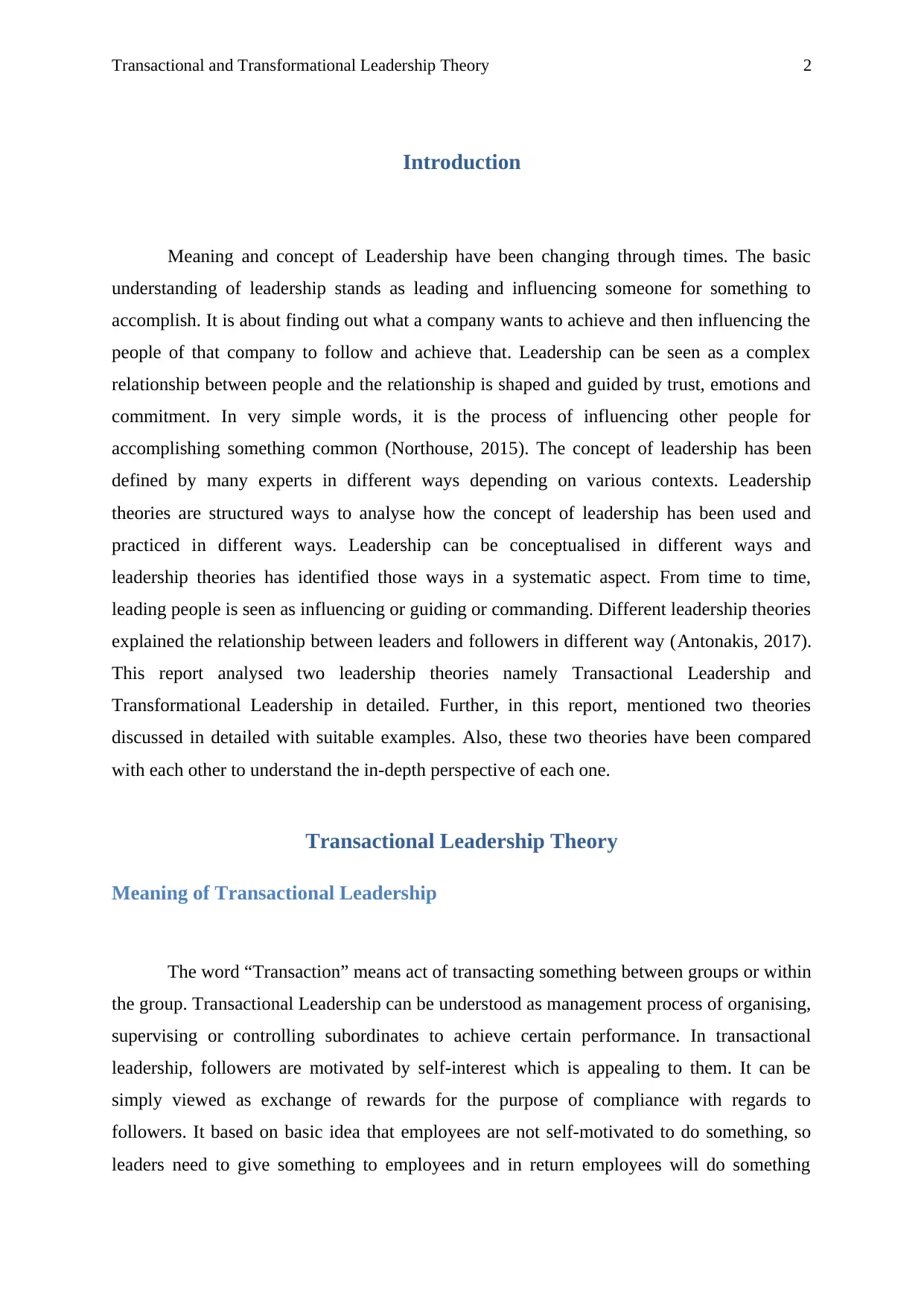
Transactional and Transformational Leadership Theory 2
Introduction
Meaning and concept of Leadership have been changing through times. The basic
understanding of leadership stands as leading and influencing someone for something to
accomplish. It is about finding out what a company wants to achieve and then influencing the
people of that company to follow and achieve that. Leadership can be seen as a complex
relationship between people and the relationship is shaped and guided by trust, emotions and
commitment. In very simple words, it is the process of influencing other people for
accomplishing something common (Northouse, 2015). The concept of leadership has been
defined by many experts in different ways depending on various contexts. Leadership
theories are structured ways to analyse how the concept of leadership has been used and
practiced in different ways. Leadership can be conceptualised in different ways and
leadership theories has identified those ways in a systematic aspect. From time to time,
leading people is seen as influencing or guiding or commanding. Different leadership theories
explained the relationship between leaders and followers in different way (Antonakis, 2017).
This report analysed two leadership theories namely Transactional Leadership and
Transformational Leadership in detailed. Further, in this report, mentioned two theories
discussed in detailed with suitable examples. Also, these two theories have been compared
with each other to understand the in-depth perspective of each one.
Transactional Leadership Theory
Meaning of Transactional Leadership
The word “Transaction” means act of transacting something between groups or within
the group. Transactional Leadership can be understood as management process of organising,
supervising or controlling subordinates to achieve certain performance. In transactional
leadership, followers are motivated by self-interest which is appealing to them. It can be
simply viewed as exchange of rewards for the purpose of compliance with regards to
followers. It based on basic idea that employees are not self-motivated to do something, so
leaders need to give something to employees and in return employees will do something
Introduction
Meaning and concept of Leadership have been changing through times. The basic
understanding of leadership stands as leading and influencing someone for something to
accomplish. It is about finding out what a company wants to achieve and then influencing the
people of that company to follow and achieve that. Leadership can be seen as a complex
relationship between people and the relationship is shaped and guided by trust, emotions and
commitment. In very simple words, it is the process of influencing other people for
accomplishing something common (Northouse, 2015). The concept of leadership has been
defined by many experts in different ways depending on various contexts. Leadership
theories are structured ways to analyse how the concept of leadership has been used and
practiced in different ways. Leadership can be conceptualised in different ways and
leadership theories has identified those ways in a systematic aspect. From time to time,
leading people is seen as influencing or guiding or commanding. Different leadership theories
explained the relationship between leaders and followers in different way (Antonakis, 2017).
This report analysed two leadership theories namely Transactional Leadership and
Transformational Leadership in detailed. Further, in this report, mentioned two theories
discussed in detailed with suitable examples. Also, these two theories have been compared
with each other to understand the in-depth perspective of each one.
Transactional Leadership Theory
Meaning of Transactional Leadership
The word “Transaction” means act of transacting something between groups or within
the group. Transactional Leadership can be understood as management process of organising,
supervising or controlling subordinates to achieve certain performance. In transactional
leadership, followers are motivated by self-interest which is appealing to them. It can be
simply viewed as exchange of rewards for the purpose of compliance with regards to
followers. It based on basic idea that employees are not self-motivated to do something, so
leaders need to give something to employees and in return employees will do something
⊘ This is a preview!⊘
Do you want full access?
Subscribe today to unlock all pages.

Trusted by 1+ million students worldwide
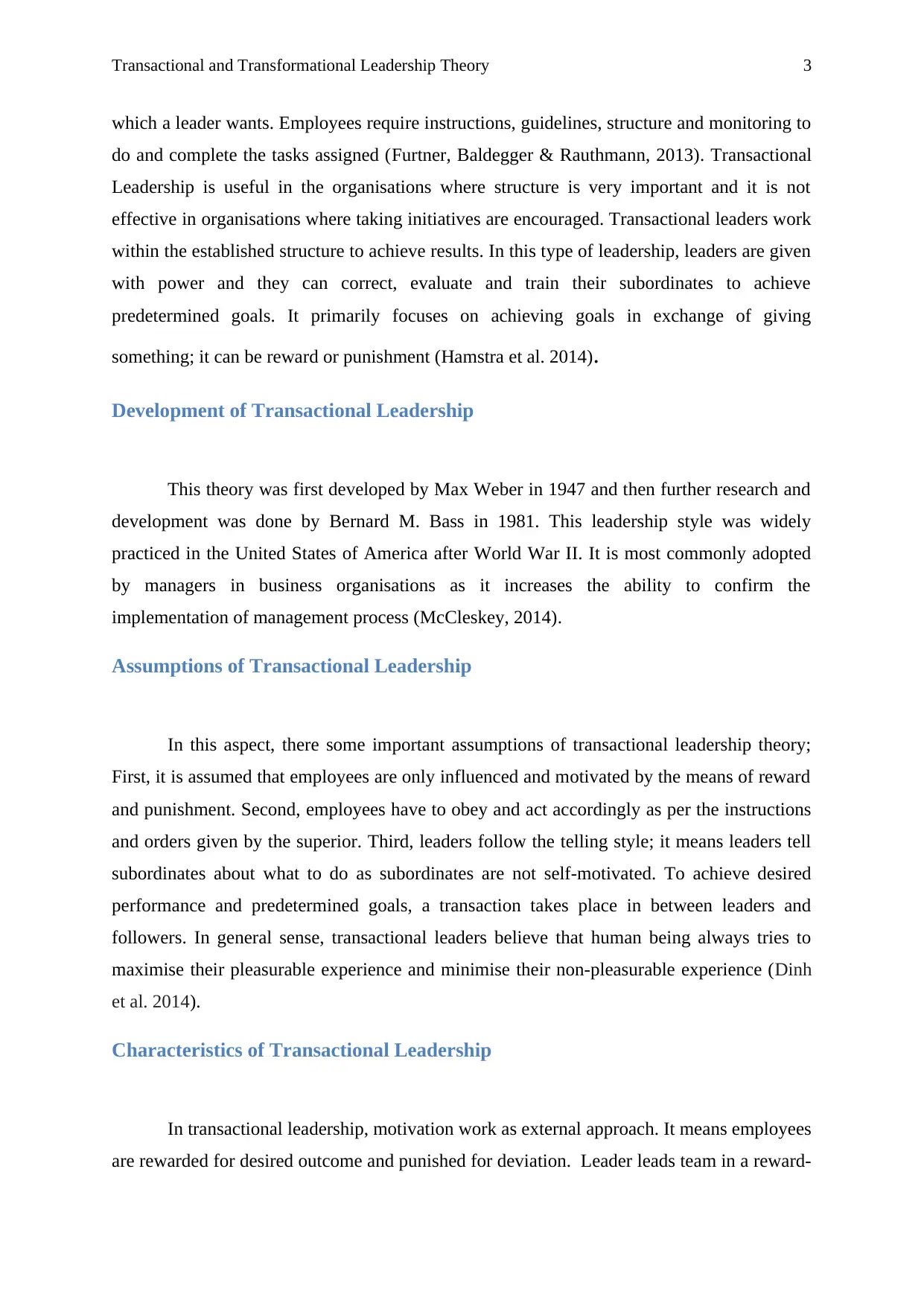
Transactional and Transformational Leadership Theory 3
which a leader wants. Employees require instructions, guidelines, structure and monitoring to
do and complete the tasks assigned (Furtner, Baldegger & Rauthmann, 2013). Transactional
Leadership is useful in the organisations where structure is very important and it is not
effective in organisations where taking initiatives are encouraged. Transactional leaders work
within the established structure to achieve results. In this type of leadership, leaders are given
with power and they can correct, evaluate and train their subordinates to achieve
predetermined goals. It primarily focuses on achieving goals in exchange of giving
something; it can be reward or punishment (Hamstra et al. 2014).
Development of Transactional Leadership
This theory was first developed by Max Weber in 1947 and then further research and
development was done by Bernard M. Bass in 1981. This leadership style was widely
practiced in the United States of America after World War II. It is most commonly adopted
by managers in business organisations as it increases the ability to confirm the
implementation of management process (McCleskey, 2014).
Assumptions of Transactional Leadership
In this aspect, there some important assumptions of transactional leadership theory;
First, it is assumed that employees are only influenced and motivated by the means of reward
and punishment. Second, employees have to obey and act accordingly as per the instructions
and orders given by the superior. Third, leaders follow the telling style; it means leaders tell
subordinates about what to do as subordinates are not self-motivated. To achieve desired
performance and predetermined goals, a transaction takes place in between leaders and
followers. In general sense, transactional leaders believe that human being always tries to
maximise their pleasurable experience and minimise their non-pleasurable experience (Dinh
et al. 2014).
Characteristics of Transactional Leadership
In transactional leadership, motivation work as external approach. It means employees
are rewarded for desired outcome and punished for deviation. Leader leads team in a reward-
which a leader wants. Employees require instructions, guidelines, structure and monitoring to
do and complete the tasks assigned (Furtner, Baldegger & Rauthmann, 2013). Transactional
Leadership is useful in the organisations where structure is very important and it is not
effective in organisations where taking initiatives are encouraged. Transactional leaders work
within the established structure to achieve results. In this type of leadership, leaders are given
with power and they can correct, evaluate and train their subordinates to achieve
predetermined goals. It primarily focuses on achieving goals in exchange of giving
something; it can be reward or punishment (Hamstra et al. 2014).
Development of Transactional Leadership
This theory was first developed by Max Weber in 1947 and then further research and
development was done by Bernard M. Bass in 1981. This leadership style was widely
practiced in the United States of America after World War II. It is most commonly adopted
by managers in business organisations as it increases the ability to confirm the
implementation of management process (McCleskey, 2014).
Assumptions of Transactional Leadership
In this aspect, there some important assumptions of transactional leadership theory;
First, it is assumed that employees are only influenced and motivated by the means of reward
and punishment. Second, employees have to obey and act accordingly as per the instructions
and orders given by the superior. Third, leaders follow the telling style; it means leaders tell
subordinates about what to do as subordinates are not self-motivated. To achieve desired
performance and predetermined goals, a transaction takes place in between leaders and
followers. In general sense, transactional leaders believe that human being always tries to
maximise their pleasurable experience and minimise their non-pleasurable experience (Dinh
et al. 2014).
Characteristics of Transactional Leadership
In transactional leadership, motivation work as external approach. It means employees
are rewarded for desired outcome and punished for deviation. Leader leads team in a reward-
Paraphrase This Document
Need a fresh take? Get an instant paraphrase of this document with our AI Paraphraser
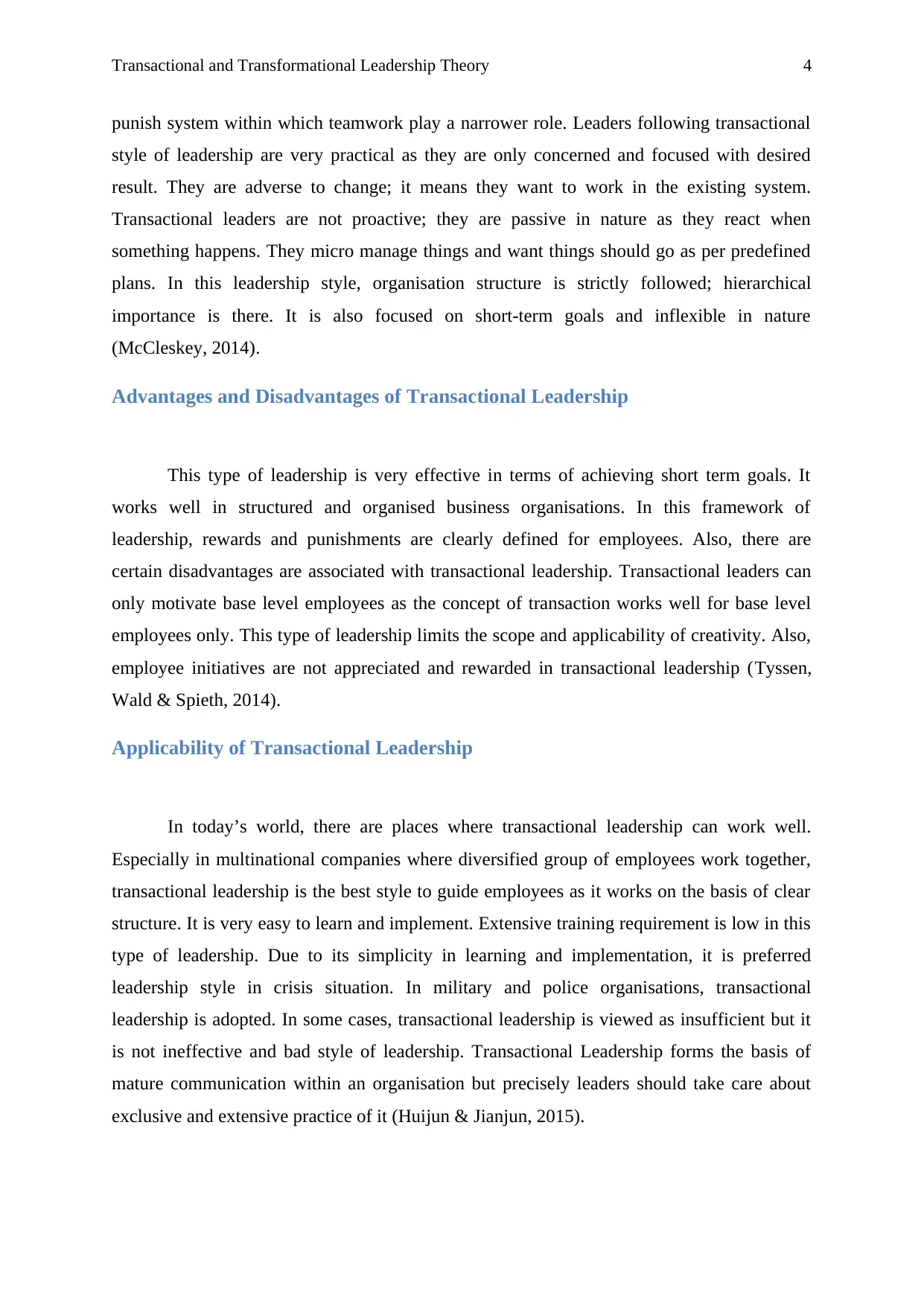
Transactional and Transformational Leadership Theory 4
punish system within which teamwork play a narrower role. Leaders following transactional
style of leadership are very practical as they are only concerned and focused with desired
result. They are adverse to change; it means they want to work in the existing system.
Transactional leaders are not proactive; they are passive in nature as they react when
something happens. They micro manage things and want things should go as per predefined
plans. In this leadership style, organisation structure is strictly followed; hierarchical
importance is there. It is also focused on short-term goals and inflexible in nature
(McCleskey, 2014).
Advantages and Disadvantages of Transactional Leadership
This type of leadership is very effective in terms of achieving short term goals. It
works well in structured and organised business organisations. In this framework of
leadership, rewards and punishments are clearly defined for employees. Also, there are
certain disadvantages are associated with transactional leadership. Transactional leaders can
only motivate base level employees as the concept of transaction works well for base level
employees only. This type of leadership limits the scope and applicability of creativity. Also,
employee initiatives are not appreciated and rewarded in transactional leadership (Tyssen,
Wald & Spieth, 2014).
Applicability of Transactional Leadership
In today’s world, there are places where transactional leadership can work well.
Especially in multinational companies where diversified group of employees work together,
transactional leadership is the best style to guide employees as it works on the basis of clear
structure. It is very easy to learn and implement. Extensive training requirement is low in this
type of leadership. Due to its simplicity in learning and implementation, it is preferred
leadership style in crisis situation. In military and police organisations, transactional
leadership is adopted. In some cases, transactional leadership is viewed as insufficient but it
is not ineffective and bad style of leadership. Transactional Leadership forms the basis of
mature communication within an organisation but precisely leaders should take care about
exclusive and extensive practice of it (Huijun & Jianjun, 2015).
punish system within which teamwork play a narrower role. Leaders following transactional
style of leadership are very practical as they are only concerned and focused with desired
result. They are adverse to change; it means they want to work in the existing system.
Transactional leaders are not proactive; they are passive in nature as they react when
something happens. They micro manage things and want things should go as per predefined
plans. In this leadership style, organisation structure is strictly followed; hierarchical
importance is there. It is also focused on short-term goals and inflexible in nature
(McCleskey, 2014).
Advantages and Disadvantages of Transactional Leadership
This type of leadership is very effective in terms of achieving short term goals. It
works well in structured and organised business organisations. In this framework of
leadership, rewards and punishments are clearly defined for employees. Also, there are
certain disadvantages are associated with transactional leadership. Transactional leaders can
only motivate base level employees as the concept of transaction works well for base level
employees only. This type of leadership limits the scope and applicability of creativity. Also,
employee initiatives are not appreciated and rewarded in transactional leadership (Tyssen,
Wald & Spieth, 2014).
Applicability of Transactional Leadership
In today’s world, there are places where transactional leadership can work well.
Especially in multinational companies where diversified group of employees work together,
transactional leadership is the best style to guide employees as it works on the basis of clear
structure. It is very easy to learn and implement. Extensive training requirement is low in this
type of leadership. Due to its simplicity in learning and implementation, it is preferred
leadership style in crisis situation. In military and police organisations, transactional
leadership is adopted. In some cases, transactional leadership is viewed as insufficient but it
is not ineffective and bad style of leadership. Transactional Leadership forms the basis of
mature communication within an organisation but precisely leaders should take care about
exclusive and extensive practice of it (Huijun & Jianjun, 2015).
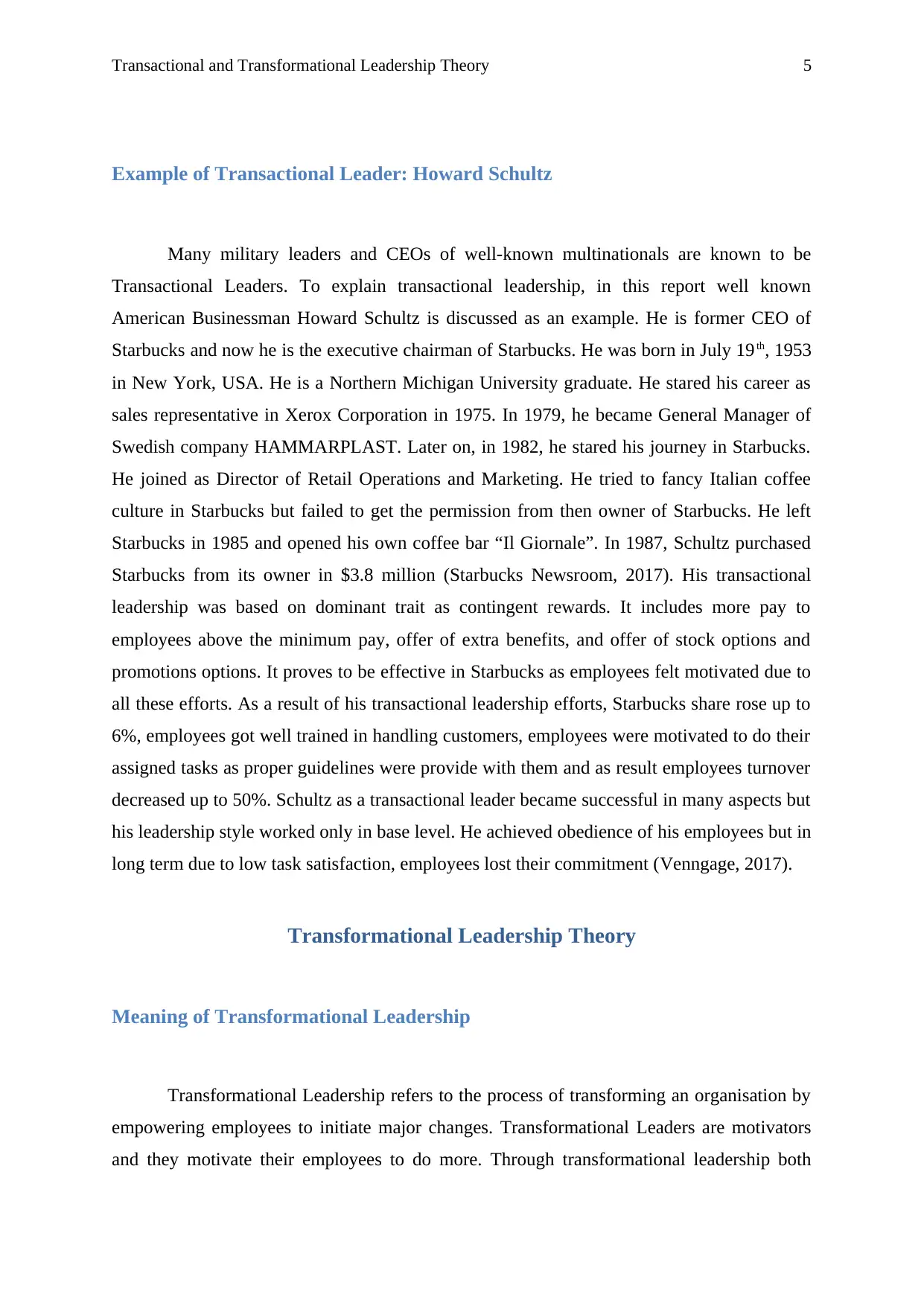
Transactional and Transformational Leadership Theory 5
Example of Transactional Leader: Howard Schultz
Many military leaders and CEOs of well-known multinationals are known to be
Transactional Leaders. To explain transactional leadership, in this report well known
American Businessman Howard Schultz is discussed as an example. He is former CEO of
Starbucks and now he is the executive chairman of Starbucks. He was born in July 19th, 1953
in New York, USA. He is a Northern Michigan University graduate. He stared his career as
sales representative in Xerox Corporation in 1975. In 1979, he became General Manager of
Swedish company HAMMARPLAST. Later on, in 1982, he stared his journey in Starbucks.
He joined as Director of Retail Operations and Marketing. He tried to fancy Italian coffee
culture in Starbucks but failed to get the permission from then owner of Starbucks. He left
Starbucks in 1985 and opened his own coffee bar “Il Giornale”. In 1987, Schultz purchased
Starbucks from its owner in $3.8 million (Starbucks Newsroom, 2017). His transactional
leadership was based on dominant trait as contingent rewards. It includes more pay to
employees above the minimum pay, offer of extra benefits, and offer of stock options and
promotions options. It proves to be effective in Starbucks as employees felt motivated due to
all these efforts. As a result of his transactional leadership efforts, Starbucks share rose up to
6%, employees got well trained in handling customers, employees were motivated to do their
assigned tasks as proper guidelines were provide with them and as result employees turnover
decreased up to 50%. Schultz as a transactional leader became successful in many aspects but
his leadership style worked only in base level. He achieved obedience of his employees but in
long term due to low task satisfaction, employees lost their commitment (Venngage, 2017).
Transformational Leadership Theory
Meaning of Transformational Leadership
Transformational Leadership refers to the process of transforming an organisation by
empowering employees to initiate major changes. Transformational Leaders are motivators
and they motivate their employees to do more. Through transformational leadership both
Example of Transactional Leader: Howard Schultz
Many military leaders and CEOs of well-known multinationals are known to be
Transactional Leaders. To explain transactional leadership, in this report well known
American Businessman Howard Schultz is discussed as an example. He is former CEO of
Starbucks and now he is the executive chairman of Starbucks. He was born in July 19th, 1953
in New York, USA. He is a Northern Michigan University graduate. He stared his career as
sales representative in Xerox Corporation in 1975. In 1979, he became General Manager of
Swedish company HAMMARPLAST. Later on, in 1982, he stared his journey in Starbucks.
He joined as Director of Retail Operations and Marketing. He tried to fancy Italian coffee
culture in Starbucks but failed to get the permission from then owner of Starbucks. He left
Starbucks in 1985 and opened his own coffee bar “Il Giornale”. In 1987, Schultz purchased
Starbucks from its owner in $3.8 million (Starbucks Newsroom, 2017). His transactional
leadership was based on dominant trait as contingent rewards. It includes more pay to
employees above the minimum pay, offer of extra benefits, and offer of stock options and
promotions options. It proves to be effective in Starbucks as employees felt motivated due to
all these efforts. As a result of his transactional leadership efforts, Starbucks share rose up to
6%, employees got well trained in handling customers, employees were motivated to do their
assigned tasks as proper guidelines were provide with them and as result employees turnover
decreased up to 50%. Schultz as a transactional leader became successful in many aspects but
his leadership style worked only in base level. He achieved obedience of his employees but in
long term due to low task satisfaction, employees lost their commitment (Venngage, 2017).
Transformational Leadership Theory
Meaning of Transformational Leadership
Transformational Leadership refers to the process of transforming an organisation by
empowering employees to initiate major changes. Transformational Leaders are motivators
and they motivate their employees to do more. Through transformational leadership both
⊘ This is a preview!⊘
Do you want full access?
Subscribe today to unlock all pages.

Trusted by 1+ million students worldwide
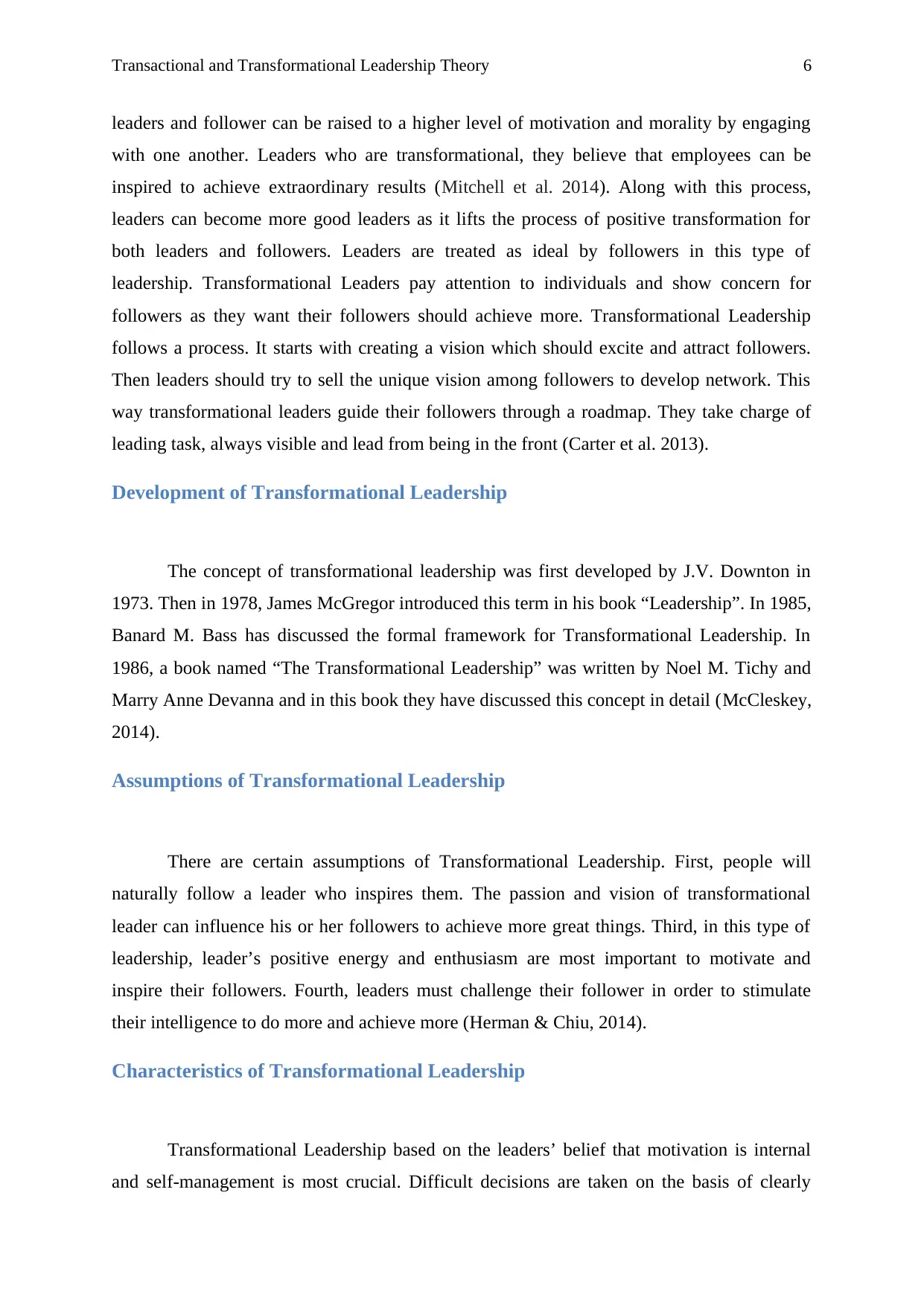
Transactional and Transformational Leadership Theory 6
leaders and follower can be raised to a higher level of motivation and morality by engaging
with one another. Leaders who are transformational, they believe that employees can be
inspired to achieve extraordinary results (Mitchell et al. 2014). Along with this process,
leaders can become more good leaders as it lifts the process of positive transformation for
both leaders and followers. Leaders are treated as ideal by followers in this type of
leadership. Transformational Leaders pay attention to individuals and show concern for
followers as they want their followers should achieve more. Transformational Leadership
follows a process. It starts with creating a vision which should excite and attract followers.
Then leaders should try to sell the unique vision among followers to develop network. This
way transformational leaders guide their followers through a roadmap. They take charge of
leading task, always visible and lead from being in the front (Carter et al. 2013).
Development of Transformational Leadership
The concept of transformational leadership was first developed by J.V. Downton in
1973. Then in 1978, James McGregor introduced this term in his book “Leadership”. In 1985,
Banard M. Bass has discussed the formal framework for Transformational Leadership. In
1986, a book named “The Transformational Leadership” was written by Noel M. Tichy and
Marry Anne Devanna and in this book they have discussed this concept in detail (McCleskey,
2014).
Assumptions of Transformational Leadership
There are certain assumptions of Transformational Leadership. First, people will
naturally follow a leader who inspires them. The passion and vision of transformational
leader can influence his or her followers to achieve more great things. Third, in this type of
leadership, leader’s positive energy and enthusiasm are most important to motivate and
inspire their followers. Fourth, leaders must challenge their follower in order to stimulate
their intelligence to do more and achieve more (Herman & Chiu, 2014).
Characteristics of Transformational Leadership
Transformational Leadership based on the leaders’ belief that motivation is internal
and self-management is most crucial. Difficult decisions are taken on the basis of clearly
leaders and follower can be raised to a higher level of motivation and morality by engaging
with one another. Leaders who are transformational, they believe that employees can be
inspired to achieve extraordinary results (Mitchell et al. 2014). Along with this process,
leaders can become more good leaders as it lifts the process of positive transformation for
both leaders and followers. Leaders are treated as ideal by followers in this type of
leadership. Transformational Leaders pay attention to individuals and show concern for
followers as they want their followers should achieve more. Transformational Leadership
follows a process. It starts with creating a vision which should excite and attract followers.
Then leaders should try to sell the unique vision among followers to develop network. This
way transformational leaders guide their followers through a roadmap. They take charge of
leading task, always visible and lead from being in the front (Carter et al. 2013).
Development of Transformational Leadership
The concept of transformational leadership was first developed by J.V. Downton in
1973. Then in 1978, James McGregor introduced this term in his book “Leadership”. In 1985,
Banard M. Bass has discussed the formal framework for Transformational Leadership. In
1986, a book named “The Transformational Leadership” was written by Noel M. Tichy and
Marry Anne Devanna and in this book they have discussed this concept in detail (McCleskey,
2014).
Assumptions of Transformational Leadership
There are certain assumptions of Transformational Leadership. First, people will
naturally follow a leader who inspires them. The passion and vision of transformational
leader can influence his or her followers to achieve more great things. Third, in this type of
leadership, leader’s positive energy and enthusiasm are most important to motivate and
inspire their followers. Fourth, leaders must challenge their follower in order to stimulate
their intelligence to do more and achieve more (Herman & Chiu, 2014).
Characteristics of Transformational Leadership
Transformational Leadership based on the leaders’ belief that motivation is internal
and self-management is most crucial. Difficult decisions are taken on the basis of clearly
Paraphrase This Document
Need a fresh take? Get an instant paraphrase of this document with our AI Paraphraser
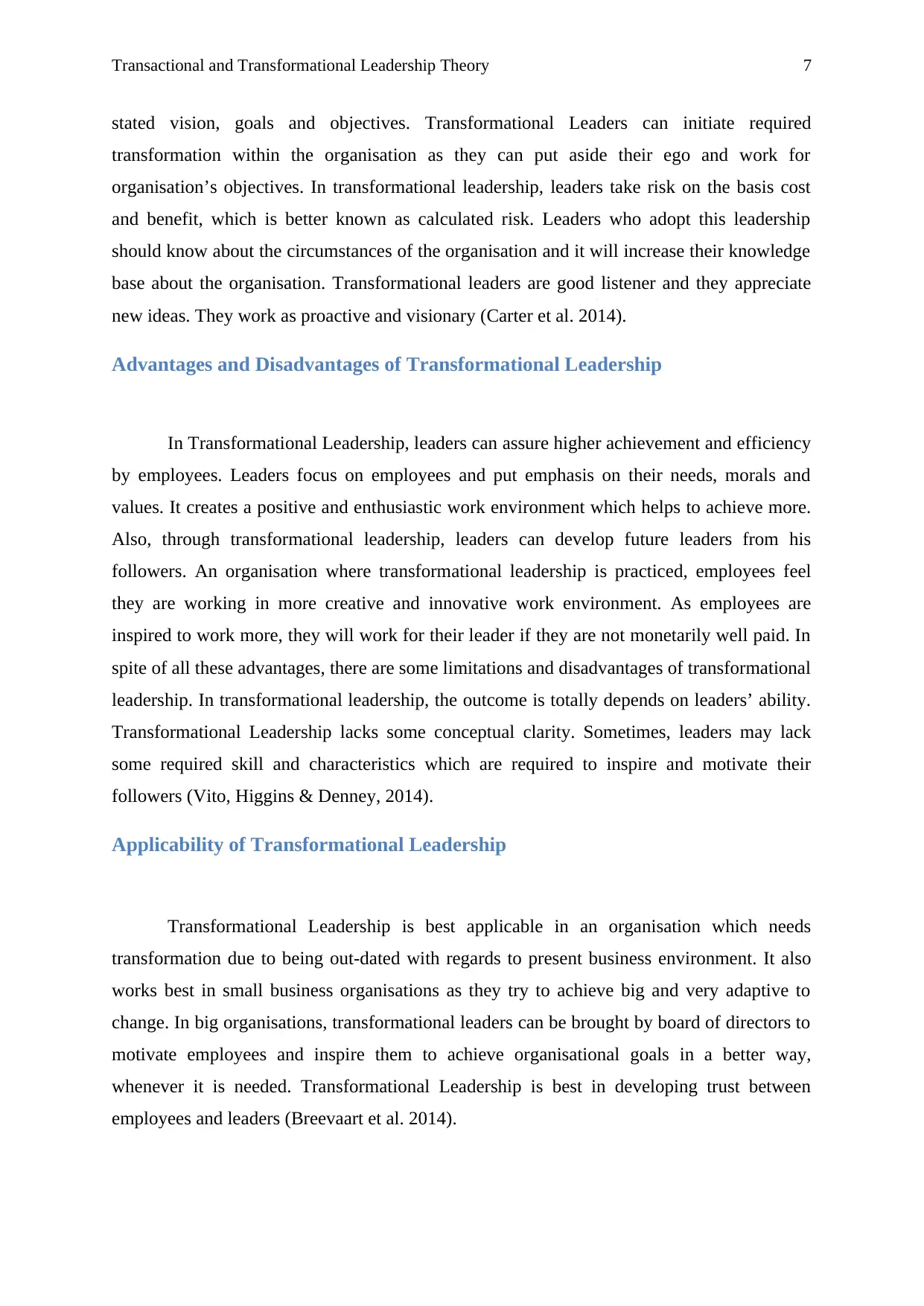
Transactional and Transformational Leadership Theory 7
stated vision, goals and objectives. Transformational Leaders can initiate required
transformation within the organisation as they can put aside their ego and work for
organisation’s objectives. In transformational leadership, leaders take risk on the basis cost
and benefit, which is better known as calculated risk. Leaders who adopt this leadership
should know about the circumstances of the organisation and it will increase their knowledge
base about the organisation. Transformational leaders are good listener and they appreciate
new ideas. They work as proactive and visionary (Carter et al. 2014).
Advantages and Disadvantages of Transformational Leadership
In Transformational Leadership, leaders can assure higher achievement and efficiency
by employees. Leaders focus on employees and put emphasis on their needs, morals and
values. It creates a positive and enthusiastic work environment which helps to achieve more.
Also, through transformational leadership, leaders can develop future leaders from his
followers. An organisation where transformational leadership is practiced, employees feel
they are working in more creative and innovative work environment. As employees are
inspired to work more, they will work for their leader if they are not monetarily well paid. In
spite of all these advantages, there are some limitations and disadvantages of transformational
leadership. In transformational leadership, the outcome is totally depends on leaders’ ability.
Transformational Leadership lacks some conceptual clarity. Sometimes, leaders may lack
some required skill and characteristics which are required to inspire and motivate their
followers (Vito, Higgins & Denney, 2014).
Applicability of Transformational Leadership
Transformational Leadership is best applicable in an organisation which needs
transformation due to being out-dated with regards to present business environment. It also
works best in small business organisations as they try to achieve big and very adaptive to
change. In big organisations, transformational leaders can be brought by board of directors to
motivate employees and inspire them to achieve organisational goals in a better way,
whenever it is needed. Transformational Leadership is best in developing trust between
employees and leaders (Breevaart et al. 2014).
stated vision, goals and objectives. Transformational Leaders can initiate required
transformation within the organisation as they can put aside their ego and work for
organisation’s objectives. In transformational leadership, leaders take risk on the basis cost
and benefit, which is better known as calculated risk. Leaders who adopt this leadership
should know about the circumstances of the organisation and it will increase their knowledge
base about the organisation. Transformational leaders are good listener and they appreciate
new ideas. They work as proactive and visionary (Carter et al. 2014).
Advantages and Disadvantages of Transformational Leadership
In Transformational Leadership, leaders can assure higher achievement and efficiency
by employees. Leaders focus on employees and put emphasis on their needs, morals and
values. It creates a positive and enthusiastic work environment which helps to achieve more.
Also, through transformational leadership, leaders can develop future leaders from his
followers. An organisation where transformational leadership is practiced, employees feel
they are working in more creative and innovative work environment. As employees are
inspired to work more, they will work for their leader if they are not monetarily well paid. In
spite of all these advantages, there are some limitations and disadvantages of transformational
leadership. In transformational leadership, the outcome is totally depends on leaders’ ability.
Transformational Leadership lacks some conceptual clarity. Sometimes, leaders may lack
some required skill and characteristics which are required to inspire and motivate their
followers (Vito, Higgins & Denney, 2014).
Applicability of Transformational Leadership
Transformational Leadership is best applicable in an organisation which needs
transformation due to being out-dated with regards to present business environment. It also
works best in small business organisations as they try to achieve big and very adaptive to
change. In big organisations, transformational leaders can be brought by board of directors to
motivate employees and inspire them to achieve organisational goals in a better way,
whenever it is needed. Transformational Leadership is best in developing trust between
employees and leaders (Breevaart et al. 2014).
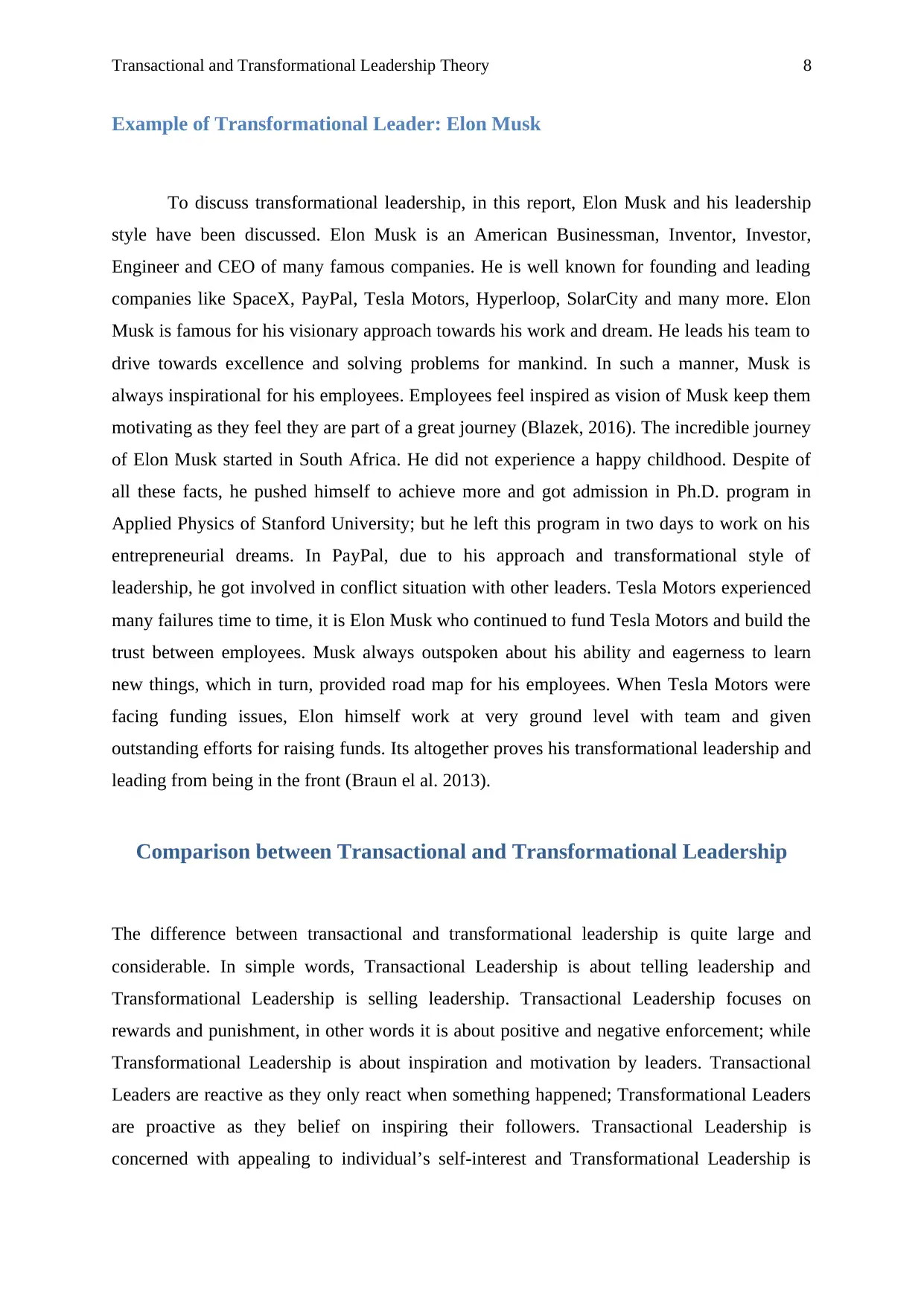
Transactional and Transformational Leadership Theory 8
Example of Transformational Leader: Elon Musk
To discuss transformational leadership, in this report, Elon Musk and his leadership
style have been discussed. Elon Musk is an American Businessman, Inventor, Investor,
Engineer and CEO of many famous companies. He is well known for founding and leading
companies like SpaceX, PayPal, Tesla Motors, Hyperloop, SolarCity and many more. Elon
Musk is famous for his visionary approach towards his work and dream. He leads his team to
drive towards excellence and solving problems for mankind. In such a manner, Musk is
always inspirational for his employees. Employees feel inspired as vision of Musk keep them
motivating as they feel they are part of a great journey (Blazek, 2016). The incredible journey
of Elon Musk started in South Africa. He did not experience a happy childhood. Despite of
all these facts, he pushed himself to achieve more and got admission in Ph.D. program in
Applied Physics of Stanford University; but he left this program in two days to work on his
entrepreneurial dreams. In PayPal, due to his approach and transformational style of
leadership, he got involved in conflict situation with other leaders. Tesla Motors experienced
many failures time to time, it is Elon Musk who continued to fund Tesla Motors and build the
trust between employees. Musk always outspoken about his ability and eagerness to learn
new things, which in turn, provided road map for his employees. When Tesla Motors were
facing funding issues, Elon himself work at very ground level with team and given
outstanding efforts for raising funds. Its altogether proves his transformational leadership and
leading from being in the front (Braun el al. 2013).
Comparison between Transactional and Transformational Leadership
The difference between transactional and transformational leadership is quite large and
considerable. In simple words, Transactional Leadership is about telling leadership and
Transformational Leadership is selling leadership. Transactional Leadership focuses on
rewards and punishment, in other words it is about positive and negative enforcement; while
Transformational Leadership is about inspiration and motivation by leaders. Transactional
Leaders are reactive as they only react when something happened; Transformational Leaders
are proactive as they belief on inspiring their followers. Transactional Leadership is
concerned with appealing to individual’s self-interest and Transformational Leadership is
Example of Transformational Leader: Elon Musk
To discuss transformational leadership, in this report, Elon Musk and his leadership
style have been discussed. Elon Musk is an American Businessman, Inventor, Investor,
Engineer and CEO of many famous companies. He is well known for founding and leading
companies like SpaceX, PayPal, Tesla Motors, Hyperloop, SolarCity and many more. Elon
Musk is famous for his visionary approach towards his work and dream. He leads his team to
drive towards excellence and solving problems for mankind. In such a manner, Musk is
always inspirational for his employees. Employees feel inspired as vision of Musk keep them
motivating as they feel they are part of a great journey (Blazek, 2016). The incredible journey
of Elon Musk started in South Africa. He did not experience a happy childhood. Despite of
all these facts, he pushed himself to achieve more and got admission in Ph.D. program in
Applied Physics of Stanford University; but he left this program in two days to work on his
entrepreneurial dreams. In PayPal, due to his approach and transformational style of
leadership, he got involved in conflict situation with other leaders. Tesla Motors experienced
many failures time to time, it is Elon Musk who continued to fund Tesla Motors and build the
trust between employees. Musk always outspoken about his ability and eagerness to learn
new things, which in turn, provided road map for his employees. When Tesla Motors were
facing funding issues, Elon himself work at very ground level with team and given
outstanding efforts for raising funds. Its altogether proves his transformational leadership and
leading from being in the front (Braun el al. 2013).
Comparison between Transactional and Transformational Leadership
The difference between transactional and transformational leadership is quite large and
considerable. In simple words, Transactional Leadership is about telling leadership and
Transformational Leadership is selling leadership. Transactional Leadership focuses on
rewards and punishment, in other words it is about positive and negative enforcement; while
Transformational Leadership is about inspiration and motivation by leaders. Transactional
Leaders are reactive as they only react when something happened; Transformational Leaders
are proactive as they belief on inspiring their followers. Transactional Leadership is
concerned with appealing to individual’s self-interest and Transformational Leadership is
⊘ This is a preview!⊘
Do you want full access?
Subscribe today to unlock all pages.

Trusted by 1+ million students worldwide
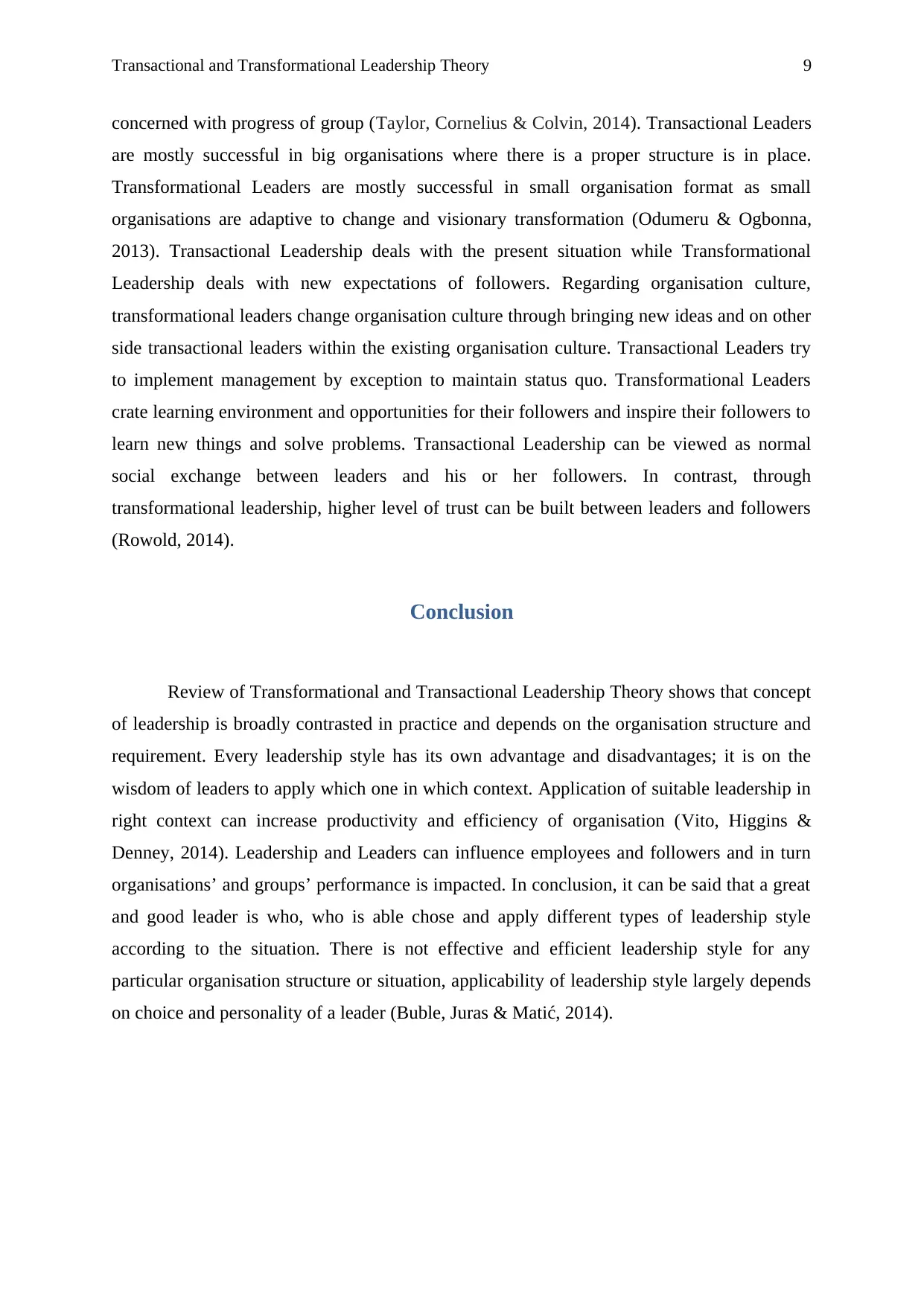
Transactional and Transformational Leadership Theory 9
concerned with progress of group (Taylor, Cornelius & Colvin, 2014). Transactional Leaders
are mostly successful in big organisations where there is a proper structure is in place.
Transformational Leaders are mostly successful in small organisation format as small
organisations are adaptive to change and visionary transformation (Odumeru & Ogbonna,
2013). Transactional Leadership deals with the present situation while Transformational
Leadership deals with new expectations of followers. Regarding organisation culture,
transformational leaders change organisation culture through bringing new ideas and on other
side transactional leaders within the existing organisation culture. Transactional Leaders try
to implement management by exception to maintain status quo. Transformational Leaders
crate learning environment and opportunities for their followers and inspire their followers to
learn new things and solve problems. Transactional Leadership can be viewed as normal
social exchange between leaders and his or her followers. In contrast, through
transformational leadership, higher level of trust can be built between leaders and followers
(Rowold, 2014).
Conclusion
Review of Transformational and Transactional Leadership Theory shows that concept
of leadership is broadly contrasted in practice and depends on the organisation structure and
requirement. Every leadership style has its own advantage and disadvantages; it is on the
wisdom of leaders to apply which one in which context. Application of suitable leadership in
right context can increase productivity and efficiency of organisation (Vito, Higgins &
Denney, 2014). Leadership and Leaders can influence employees and followers and in turn
organisations’ and groups’ performance is impacted. In conclusion, it can be said that a great
and good leader is who, who is able chose and apply different types of leadership style
according to the situation. There is not effective and efficient leadership style for any
particular organisation structure or situation, applicability of leadership style largely depends
on choice and personality of a leader (Buble, Juras & Matić, 2014).
concerned with progress of group (Taylor, Cornelius & Colvin, 2014). Transactional Leaders
are mostly successful in big organisations where there is a proper structure is in place.
Transformational Leaders are mostly successful in small organisation format as small
organisations are adaptive to change and visionary transformation (Odumeru & Ogbonna,
2013). Transactional Leadership deals with the present situation while Transformational
Leadership deals with new expectations of followers. Regarding organisation culture,
transformational leaders change organisation culture through bringing new ideas and on other
side transactional leaders within the existing organisation culture. Transactional Leaders try
to implement management by exception to maintain status quo. Transformational Leaders
crate learning environment and opportunities for their followers and inspire their followers to
learn new things and solve problems. Transactional Leadership can be viewed as normal
social exchange between leaders and his or her followers. In contrast, through
transformational leadership, higher level of trust can be built between leaders and followers
(Rowold, 2014).
Conclusion
Review of Transformational and Transactional Leadership Theory shows that concept
of leadership is broadly contrasted in practice and depends on the organisation structure and
requirement. Every leadership style has its own advantage and disadvantages; it is on the
wisdom of leaders to apply which one in which context. Application of suitable leadership in
right context can increase productivity and efficiency of organisation (Vito, Higgins &
Denney, 2014). Leadership and Leaders can influence employees and followers and in turn
organisations’ and groups’ performance is impacted. In conclusion, it can be said that a great
and good leader is who, who is able chose and apply different types of leadership style
according to the situation. There is not effective and efficient leadership style for any
particular organisation structure or situation, applicability of leadership style largely depends
on choice and personality of a leader (Buble, Juras & Matić, 2014).
Paraphrase This Document
Need a fresh take? Get an instant paraphrase of this document with our AI Paraphraser
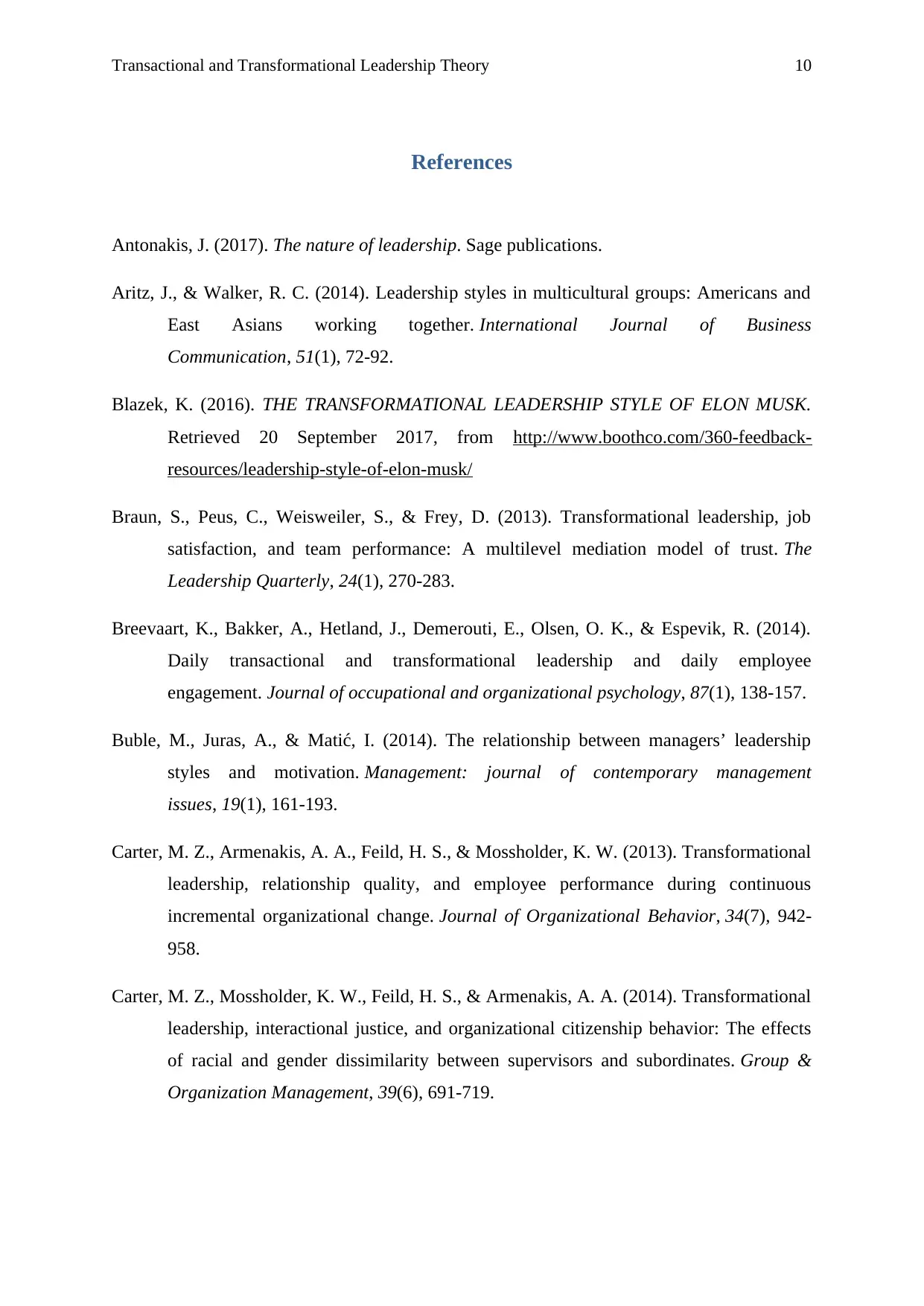
Transactional and Transformational Leadership Theory 10
References
Antonakis, J. (2017). The nature of leadership. Sage publications.
Aritz, J., & Walker, R. C. (2014). Leadership styles in multicultural groups: Americans and
East Asians working together. International Journal of Business
Communication, 51(1), 72-92.
Blazek, K. (2016). THE TRANSFORMATIONAL LEADERSHIP STYLE OF ELON MUSK.
Retrieved 20 September 2017, from http://www.boothco.com/360-feedback-
resources/leadership-style-of-elon-musk/
Braun, S., Peus, C., Weisweiler, S., & Frey, D. (2013). Transformational leadership, job
satisfaction, and team performance: A multilevel mediation model of trust. The
Leadership Quarterly, 24(1), 270-283.
Breevaart, K., Bakker, A., Hetland, J., Demerouti, E., Olsen, O. K., & Espevik, R. (2014).
Daily transactional and transformational leadership and daily employee
engagement. Journal of occupational and organizational psychology, 87(1), 138-157.
Buble, M., Juras, A., & Matić, I. (2014). The relationship between managers’ leadership
styles and motivation. Management: journal of contemporary management
issues, 19(1), 161-193.
Carter, M. Z., Armenakis, A. A., Feild, H. S., & Mossholder, K. W. (2013). Transformational
leadership, relationship quality, and employee performance during continuous
incremental organizational change. Journal of Organizational Behavior, 34(7), 942-
958.
Carter, M. Z., Mossholder, K. W., Feild, H. S., & Armenakis, A. A. (2014). Transformational
leadership, interactional justice, and organizational citizenship behavior: The effects
of racial and gender dissimilarity between supervisors and subordinates. Group &
Organization Management, 39(6), 691-719.
References
Antonakis, J. (2017). The nature of leadership. Sage publications.
Aritz, J., & Walker, R. C. (2014). Leadership styles in multicultural groups: Americans and
East Asians working together. International Journal of Business
Communication, 51(1), 72-92.
Blazek, K. (2016). THE TRANSFORMATIONAL LEADERSHIP STYLE OF ELON MUSK.
Retrieved 20 September 2017, from http://www.boothco.com/360-feedback-
resources/leadership-style-of-elon-musk/
Braun, S., Peus, C., Weisweiler, S., & Frey, D. (2013). Transformational leadership, job
satisfaction, and team performance: A multilevel mediation model of trust. The
Leadership Quarterly, 24(1), 270-283.
Breevaart, K., Bakker, A., Hetland, J., Demerouti, E., Olsen, O. K., & Espevik, R. (2014).
Daily transactional and transformational leadership and daily employee
engagement. Journal of occupational and organizational psychology, 87(1), 138-157.
Buble, M., Juras, A., & Matić, I. (2014). The relationship between managers’ leadership
styles and motivation. Management: journal of contemporary management
issues, 19(1), 161-193.
Carter, M. Z., Armenakis, A. A., Feild, H. S., & Mossholder, K. W. (2013). Transformational
leadership, relationship quality, and employee performance during continuous
incremental organizational change. Journal of Organizational Behavior, 34(7), 942-
958.
Carter, M. Z., Mossholder, K. W., Feild, H. S., & Armenakis, A. A. (2014). Transformational
leadership, interactional justice, and organizational citizenship behavior: The effects
of racial and gender dissimilarity between supervisors and subordinates. Group &
Organization Management, 39(6), 691-719.
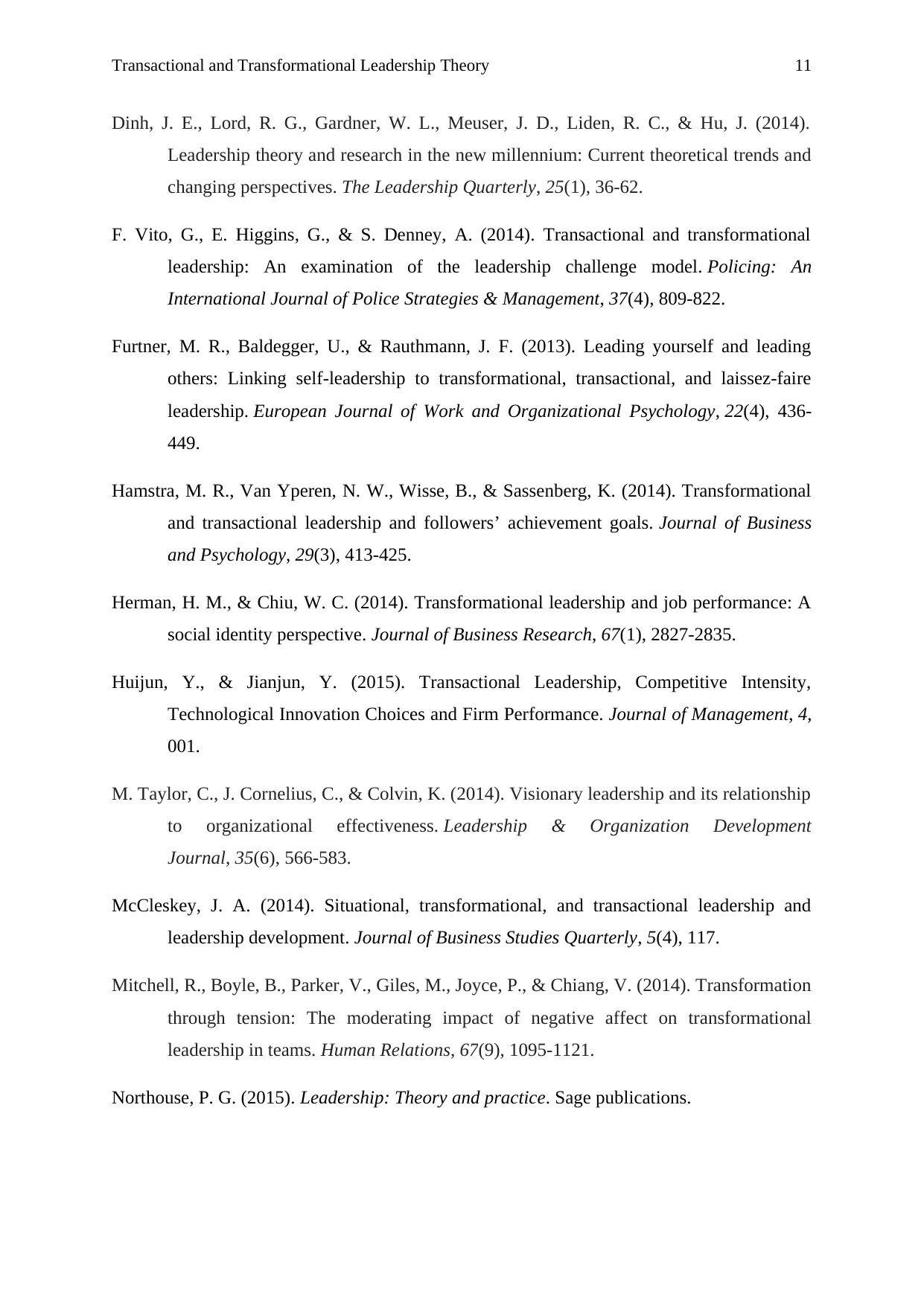
Transactional and Transformational Leadership Theory 11
Dinh, J. E., Lord, R. G., Gardner, W. L., Meuser, J. D., Liden, R. C., & Hu, J. (2014).
Leadership theory and research in the new millennium: Current theoretical trends and
changing perspectives. The Leadership Quarterly, 25(1), 36-62.
F. Vito, G., E. Higgins, G., & S. Denney, A. (2014). Transactional and transformational
leadership: An examination of the leadership challenge model. Policing: An
International Journal of Police Strategies & Management, 37(4), 809-822.
Furtner, M. R., Baldegger, U., & Rauthmann, J. F. (2013). Leading yourself and leading
others: Linking self-leadership to transformational, transactional, and laissez-faire
leadership. European Journal of Work and Organizational Psychology, 22(4), 436-
449.
Hamstra, M. R., Van Yperen, N. W., Wisse, B., & Sassenberg, K. (2014). Transformational
and transactional leadership and followers’ achievement goals. Journal of Business
and Psychology, 29(3), 413-425.
Herman, H. M., & Chiu, W. C. (2014). Transformational leadership and job performance: A
social identity perspective. Journal of Business Research, 67(1), 2827-2835.
Huijun, Y., & Jianjun, Y. (2015). Transactional Leadership, Competitive Intensity,
Technological Innovation Choices and Firm Performance. Journal of Management, 4,
001.
M. Taylor, C., J. Cornelius, C., & Colvin, K. (2014). Visionary leadership and its relationship
to organizational effectiveness. Leadership & Organization Development
Journal, 35(6), 566-583.
McCleskey, J. A. (2014). Situational, transformational, and transactional leadership and
leadership development. Journal of Business Studies Quarterly, 5(4), 117.
Mitchell, R., Boyle, B., Parker, V., Giles, M., Joyce, P., & Chiang, V. (2014). Transformation
through tension: The moderating impact of negative affect on transformational
leadership in teams. Human Relations, 67(9), 1095-1121.
Northouse, P. G. (2015). Leadership: Theory and practice. Sage publications.
Dinh, J. E., Lord, R. G., Gardner, W. L., Meuser, J. D., Liden, R. C., & Hu, J. (2014).
Leadership theory and research in the new millennium: Current theoretical trends and
changing perspectives. The Leadership Quarterly, 25(1), 36-62.
F. Vito, G., E. Higgins, G., & S. Denney, A. (2014). Transactional and transformational
leadership: An examination of the leadership challenge model. Policing: An
International Journal of Police Strategies & Management, 37(4), 809-822.
Furtner, M. R., Baldegger, U., & Rauthmann, J. F. (2013). Leading yourself and leading
others: Linking self-leadership to transformational, transactional, and laissez-faire
leadership. European Journal of Work and Organizational Psychology, 22(4), 436-
449.
Hamstra, M. R., Van Yperen, N. W., Wisse, B., & Sassenberg, K. (2014). Transformational
and transactional leadership and followers’ achievement goals. Journal of Business
and Psychology, 29(3), 413-425.
Herman, H. M., & Chiu, W. C. (2014). Transformational leadership and job performance: A
social identity perspective. Journal of Business Research, 67(1), 2827-2835.
Huijun, Y., & Jianjun, Y. (2015). Transactional Leadership, Competitive Intensity,
Technological Innovation Choices and Firm Performance. Journal of Management, 4,
001.
M. Taylor, C., J. Cornelius, C., & Colvin, K. (2014). Visionary leadership and its relationship
to organizational effectiveness. Leadership & Organization Development
Journal, 35(6), 566-583.
McCleskey, J. A. (2014). Situational, transformational, and transactional leadership and
leadership development. Journal of Business Studies Quarterly, 5(4), 117.
Mitchell, R., Boyle, B., Parker, V., Giles, M., Joyce, P., & Chiang, V. (2014). Transformation
through tension: The moderating impact of negative affect on transformational
leadership in teams. Human Relations, 67(9), 1095-1121.
Northouse, P. G. (2015). Leadership: Theory and practice. Sage publications.
⊘ This is a preview!⊘
Do you want full access?
Subscribe today to unlock all pages.

Trusted by 1+ million students worldwide
1 out of 13
Related Documents
Your All-in-One AI-Powered Toolkit for Academic Success.
+13062052269
info@desklib.com
Available 24*7 on WhatsApp / Email
![[object Object]](/_next/static/media/star-bottom.7253800d.svg)
Unlock your academic potential
Copyright © 2020–2025 A2Z Services. All Rights Reserved. Developed and managed by ZUCOL.





